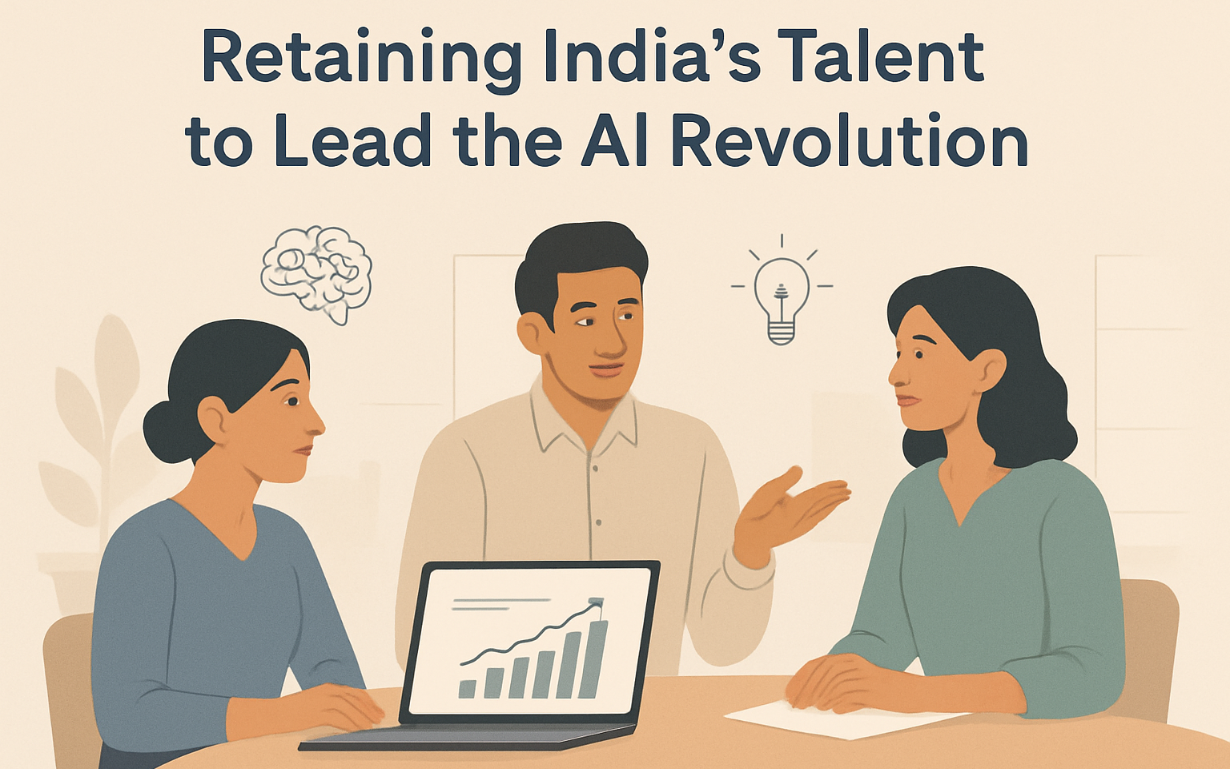India is at the center of the technological shift. The world is witnessing the start of the AI era, and India is the country that can lead the way thanks to its huge number of engineers, data scientists, and users who speak many languages. But one obstacle from the past still exists: brain drain. As per the tech industry’s estimates, India contributes around 15% of the total AI talent in the world—but a great number of them choose to go abroad.
The Opportunity: India’s AI Moment
In the competition for next-gen intelligence development, India makes a very strong case for itself. On the one hand, the government and business are working together in a big way to create home-grown large-language-models (LLMs)—the biggest AI systems that can outperform even the likes of OpenAI and Google. On the other hand, India has an unexpectedly big advantage: it’s a country with multilingual intelligence.
Such a scenario will entail not just the world’s markets being served by the Indian model but also the rural population, local businesses, government projects, and an entire segment of the population that is often overlooked by the global monolingual models.
The Challenge: Why Talent Still Leaves
Despite the potential, India is losing its own. Here’s why:
- Many Indian AI professionals migrate abroad for better pay, research facilities, global exposure, and better-defined career tracks.
- Academia and industry in India are often siloed: strong research exists—but the links to high-end commercial AI and deep-tech startups are weaker.
- Public funding for advanced AI research remains modest compared to leading global labs.
- Indian AI talent often ends up in global outsourcing or services roles rather than core research or product-innovation roles.
A venture capitalist notes: “India’s tech talent pool is one of its most significant assets, but more and more talent is leaving for better returns.” He argues that unless India not only builds an AI ecosystem but also actively retains and rewards its top-tier talent, the promise of leadership will remain just that—a promise.
What India Must Do Now
To change the situation from being a mere talent supplier to an AI innovation hub, India must act fast on multiple fronts:
1. Fund AI Research Broadly
AI centers of excellence should be set up not only in the top metros but also in the tier-2 and tier-3 cities. The research of various disciplines such as linguistics, social science, and local business applications with AI should be encouraged.
2. Make Staying Attractive
The top researchers that India has to rely on must be given an attractive stay by the government, whose support is critical. It would include fellowships, competitive salaries (on a par with global labs), PhDs with industry linkages, incentives for returning researchers, and career tracks that combine research and product development.
3. Support Deep-Tech Startups
The government should motivate the investors to pour their money into AI start-ups that provide solutions to the local problems by scaling them up: rural business multilingual chatbots, AI for healthcare in India, and agriculture-AI customized to the East Indian soil conditions. These firms allow the specialized workforce to craft significant products locally rather than just rendering services.
4. Build International Linkages
Facilitate the participation of overseas Indian-origin researchers in national programs (even from a distance). Form a partnership with the leading global AI research labs. Set up student exchange programs. This not only returns the expertise but also elevates India’s position in the global AI arena.
5. Showcase India’s Ambition
The trajectory of India’s economy is towards a $10 trillion future. To put it in the words of Khare, “Here, the opportunities will be on a global scale.” By hosting events like the Global AI Summit 2026, India can demonstrate its wish to be a leader not merely a follower.
India’s Multilingual Advantage
The global AI models very often struggle in the area of language diversity, cultural context, and local usability. Here India may extract the most from its elephantine size. If an Indian AI is able to not only understand Hindi, Tamil, Bengali, Marathi, and Punjabi but to also do so in a culturally correct way—it may render a huge impact.
- It can cater the regional businesses in regional languages.
- It can deliver governmental programs and rural users who are not fluent in English.
- It can also give a push to multilingual education, local language voice assistants, and inclusive AI that can bridge the digital divide.
This not only turns AI into a commercial product but also into a development tool. It also means that Indian talent is not just relevant but necessary in the adoption of new ways of solving global problems.
The Stakes and the Opportunity
India is no longer only a global tech labour supplier but it is also a potential AI powerhouse if it continues to keep its talent at home. The phenomenon of brain-drain that once appeared as a fait accompli now looks as a government policy and ecosystem failure that can be rectified.
India should invest in its intellectuals, financially support its innovators, and create an atmosphere where the new ideas of the future can emerge—not in other places but right here. As Rajat Khare says, “The government has been actively promoting AI… but the actual challenge will be how successfully we can keep and develop our talent. That will be the major factor determining whether we lead the way or follow.”
FAQs (Most Frequently Asked Questions)
Q1. What is the significance of brain-drain for India’s AI ambitions?
Although India is known for its exceptional engineering talent, a major part of it goes to the foreign market or is engaged in low-end jobs. The country has to stop holding on to that talent, being in the innovation step and having the local market the world over as its customer. This is the way to build AI models and deep-tech products that are globally competitive—not just services.
Q2. Is it possible for India to compete with AI labs like OpenAI or Google’s AI department?
India might not be able to exactly duplicate them—but the power lies in doing things in a different way: building models for local languages, regional use-cases, combining global ambition with local relevance. If the ecosystem aligns—talent retained, infrastructure built—India’s AI leadership is plausible.
Q3. Which sorts of startups should India concentrate on to keep its AI talent?
Startups that are working to resolve both local and global issues, such as AI in healthcare, agriculture, and education using local languages; voice assistants for regional languages; AI for regional business automation; multilingual customer-service bots; deep-tech research in natural-language-processing for Indian languages.
Q4. How can American academia and industry connect more in India?
Joint research programmes, industry-funded labs at universities, PhD programmes aligned with startup product-goals, and researchers having the option to switch between academic and product roles are some ways of connecting industry and academia in India.
Q5. How can the government make it worth the while for AI talent to reside in India?
They can provide scholarships and grants for top researchers; offer attractive salaries; invest in the infrastructure of GPU clusters and LLM training centres; run talent return programmes; grant tax breaks on deep-tech investments; support international collaborations and scholarships.




Leave a Reply